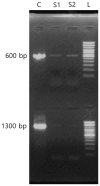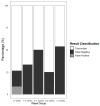Enhanced Detection of Bacterial Ocular Pathogens: A Comparative Study of Broad-Range Real-Time PCR and Conventional Culture Methods
- PMID: 40310352
- PMCID: PMC12025706
- DOI: 10.3390/diagnostics15080966
Enhanced Detection of Bacterial Ocular Pathogens: A Comparative Study of Broad-Range Real-Time PCR and Conventional Culture Methods
Abstract
Background: Ocular infections can cause severe complications, including blindness, and distinguishing bacterial from fungal keratitis based on clinical features alone is difficult. This study compared broad-range conventional PCR and real-time PCR methods targeting the 16S rRNA gene with traditional culture for diagnosing bacterial ocular infections. Methods: We analyzed 160 ocular specimens from 111 patients, categorizing them as septic or aseptic. The results of both conventional PCR and real-time PCR methods targeting the 16S rRNA gene were compared with traditional culture outcomes. Results: Real-time PCR demonstrated higher sensitivity than conventional PCR, and receiver operating characteristic analysis determined optimal ΔCT cutoff values of -2.13 and -4.09 for septic and aseptic specimens, respectively. Delays in specimen processing significantly affected real-time PCR accuracy. The 16S rRNA meta-taxonomic analysis using nanopore sequencing only validated the PCR results when the DNA concentration was sufficient. Conclusions: Broad-range real-time PCR proved to be a valuable diagnostic tool, particularly in aseptic specimens, with greater sensitivity and specificity than conventional PCR. The established ΔCT cutoff values improved diagnostic accuracy and showed that standardized specimen collection and processing are crucial for maximizing PCR efficacy.
Keywords: broad-range PCR; ocular infections; real-time PCR.
Conflict of interest statement
The authors declare no conflicts of interest.
Figures




Similar articles
-
Diagnostic yield of broad-range 16s rRNA gene PCR varies by sample type and is improved by the addition of qPCR panels targeting the most common causative organisms.J Med Microbiol. 2022 Dec;71(12). doi: 10.1099/jmm.0.001633. J Med Microbiol. 2022. PMID: 36748452
-
Diagnosis of prosthetic joint infections using UMD-Universal Kit and the automated multiplex-PCR Unyvero i60 ITI(®) cartridge system: a pilot study.Infection. 2015 Oct;43(5):551-60. doi: 10.1007/s15010-015-0796-4. Epub 2015 May 29. Infection. 2015. PMID: 26021312
-
[A broad-range 16S rRNA gene real-time PCR assay for the diagnosis of neonatal septicemia].Zhonghua Er Ke Za Zhi. 2007 Jun;45(6):446-9. Zhonghua Er Ke Za Zhi. 2007. PMID: 17880793 Chinese.
-
Development and evaluation of a novel fast broad-range 16S ribosomal DNA PCR and sequencing assay for diagnosis of bacterial infective endocarditis: multi-year experience in a large Canadian healthcare zone and a literature review.BMC Infect Dis. 2016 Apr 12;16:146. doi: 10.1186/s12879-016-1476-4. BMC Infect Dis. 2016. PMID: 27066823 Free PMC article. Review.
-
Nucleic acid and antigen detection tests for leptospirosis.Cochrane Database Syst Rev. 2019 Aug 1;8(8):CD011871. doi: 10.1002/14651858.CD011871.pub2. Cochrane Database Syst Rev. 2019. PMID: 31425612 Free PMC article.
References
Grants and funding
LinkOut - more resources
Full Text Sources

